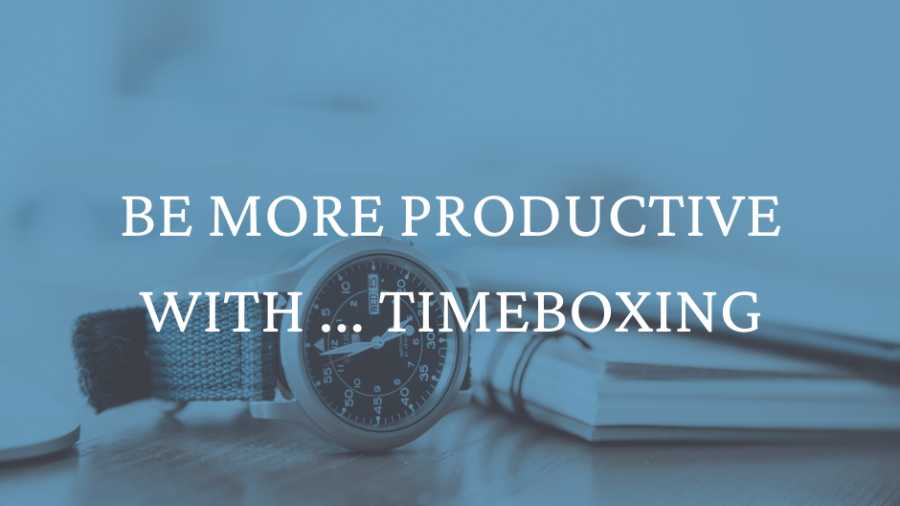More and more to do. Less and less time and resources to cope with the mountain of tasks. Many are all-too-familiar with this challenge. In no particular order, I write about the methods that help me to complete important tasks on time. This time: timeboxing or “living in the calendar” (not to worry: it’s not as bad as it sounds!).
There used to be a moment of reckoning in my working week: Thursday afternoon, when I realised there was too little week left for too many tasks. Sometimes I got in over my head, but even when that wasn’t the case, it always led to frustration. We know that we can never “do it all”. But we get annoyed when we’ve been busy all day but still haven’t done what we needed to do.
Why to-do lists don’t work
For too long, I beat myself up over it. Coaching clients also do it: I’m not disciplined enough. I’m too slow. Too this, too that. Definitely my fault. Daniel Markovitz sees things differently. In 2012, he wrote in the Harvard Business Review that to-do lists don’t work – “they only cause frustration and failure”.[1][2]
- Overburdened by too many choices: What should I do first: the minutes, the important email or the call to a customer? (Okay, first get a coffee, check social media …)
- Preference for simple tasks: On a list, all tasks look the same. They’re three or four words long. We choose the ones that are easiest to check off the list (dopamine rush!).
- Completion of urgent, short-term tasks: We are more likely to postpone the important, but perhaps not (yet) so urgent, to-dos (tax returns, training course).
- Lack of context: To-do lists don’t reflect how much time is available for a task (and whether I have to work on it in a concentrated way or can also do it quickly between meetings or while travelling).
- Lack of commitment: When we write a task on the list, it means that we intend to complete it, but not how or when (exactly).
How does timeboxing work?
In timeboxing, tasks are entered as an appointment with oneself in the calendar. So I “commit” to a specific time and duration in which I will do the task. For writing a concept, for example, I schedule two hours on a Monday morning because I’m more focused in the morning. At the same time, I plan another hour for editing the following day and think about how early I need to start the task in order to be able to get feedback from others in good time.
Why does timeboxing work?
In 1967, management guru Peter Drucker wrote: “Effective executives, in my observation, do not start with their tasks. They start with their time.” Indeed, oftentimes it’s not so much about “doing our best” as doing the right thing at the right time. Time management with timeboxing helps:
- Find the right time: By anchoring a task in the calendar, I not only think about how much time I want to give the task, but also when. When am I most focused, what tasks do I still do well when I’m already running on fumes?
- Improve collaboration: If my to-dos are on the calendar, meetings will take place outside of the time blocks I have set aside for working on my most important tasks (note: there’s no rule without exceptions, but even if this only succeeds most of the time, that’s already a win).
- Prioritize: A to-do list can be infinite, but your time is not. Timeboxing elegantly forces you to select the most important two or three tasks of the day or week.
- Establish who’s in charge: I control my to-do list, not the other way around. This point should not be underestimated, because the feeling of self-realization and control is an important factor for motivation, energy and satisfaction at work.
For me it’s clear: timeboxing makes me more productive. I can allocate 5 hours of time in my calendar to researching and writing this blog article or set no limit – in which case it can easily “take” two or three times as long. The article won’t necessarily be any better, but the movie date or workout is scratched all the same.
Timeboxing: the light version
It’s a good idea to experiment with how you want to implement the timeboxing principle. For example, I don’t plan every task in the calendar, but work with a flexible system:
- in which the most important 2-3 weekly tasks are scheduled in the calendar (and I go into the weekend with a good feeling)
- in which there is at least 1 to 2 hours of buffer time per day for spontaneous appointments or unforeseen events
- in which daily time for answering emails is firmly scheduled
- in which all private appointments are on the calendar (so I don’t subconsciously consider workouts, cinema and appointments less important than work)
But, but, but …
And when I find myself annoyed that the calendar doesn’t provide enough time for all the to-dos, I tell myself that timeboxing simply reflects reality: too much is too much. Timeboxing and a glance at my calendar then force me to prioritise. Or keep me from taking on even more in spite of myself. Because when it comes to time, the principle of responsibility is particularly essential: WE need to set expectations about what we can achieve with the (working) time we have.
You want to be more productive without overworking yourself? Read my blog article about the role of energy and breaks – or let’s explore how I can support you.
[1] Daniel Markovitz, To-Do Lists Don’t Work, in: Harvard Business Manager, 24 January 2012.
[2] Marc Zao-Sanders, How Timeboxing Works and Why It Will Make You More Productive, in: Harvard Business Manager, 12 December 2018.

0 Comments